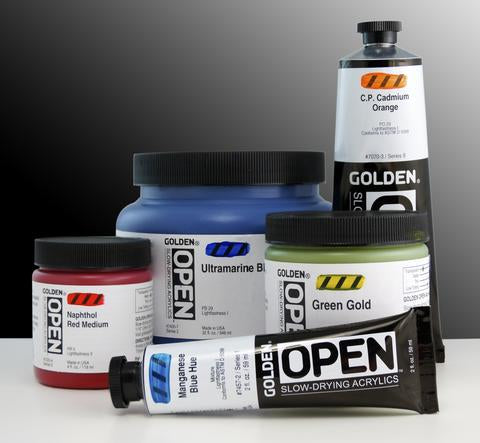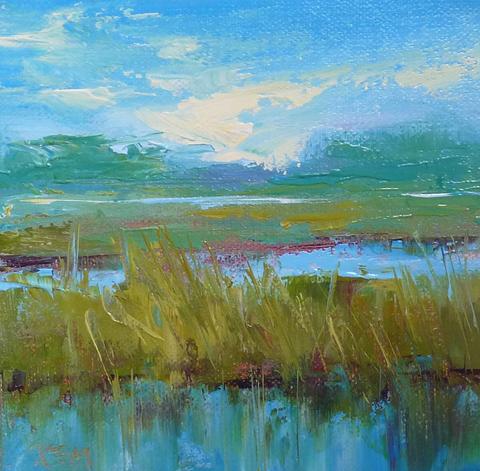Golden OPEN Acrylics
An acrylic paint with vastly longer working time and colours that can be lifted or blended even hours after application...?
It's not magic, it's Golden OPEN and it’s the real deal!

Summer brings to our lives joyous colours, warm weather, and the inspiration and motivation to paint. If you're an acrylic painter, then you will likely have encountered the frustrations of working in warm weather (such as paint drying on your brush and palette, before you can even get it on the canvas!)
How does OPEN differ from a regular acrylic paint?
Soft Body
Regular professional quality acrylics are a heavy-body paint, meaning the colours come out of the tube in a very thick, paste-like consistency. Golden's OPEN Acrylics are an acrylic paint with a slightly softer consistency than a traditional heavy bodied paint. OPEN colours have "self-leveling" properties (meaning that high peaks and deep texture will flatten out somewhat as the paint film dries and cures).

Slow-Drying
Golden OPEN was developed as a very slow drying acrylic paint, allowing for a significantly lengthened working time. Having many more hours of working time with your acrylics opens up a wide range of traditional painting techniques once possible only for oil painters. The lengthy working time also enables painters to use covered palettes or sealed containers to preserve the colours on their palette for extended periods of time (sometime even for weeks!), reducing the amount of paint wasted and saving colour mixtures for future use.

Plein Air Painting by Karen Margulis using Golden OPEN
OPEN Mediums & Additives
Thinner
Golden Open contains a special ingredient (different from all other acrylics) that allows it to dry so slowly. The OPEN thinner is a concentrated bottle of this same water-based, slow-drying additive. OPEN Thinner works only with OPEN acrylics.

A standard acrylic retarder does not work with OPEN acrylics and conversely, OPEN Thinner does not work with regular acrylics.
If you wish to extend the working time and you are using a mixture of regular acrylics and OPEN, then default to using the thinner instead of a retarder
Gel & Fluid Medium
In addition to the Thinner, Golden has developed Gels and Mediums to compliment the OPEN acrylics - both are available in Gloss or Matte
Gel: The consistency of Gel is just as it sounds, thick, like hair gel. Gels are great for extending full-bodied acrylics without changing their working properties.
Medium: mediums are an acrylic fluid that will both extend and thin the body of regular full-bodied acrylic colours.
Playing with Time

Another wonderful characteristic of these paints is it's quite easy to customize the length of open working time.
To Speed Drying
- mix OPEN with other faster-drying acrylics (such as regular Heavy Body colours).
The higher the ratio of regular (fast-drying) acrylics , the faster it the mixture will dry.
To Slow Drying
- use OPEN colours at full strength or use Thinner to increase (or maintain) open working time
- Avoid thick applications as they can dry extremely slowly. It's recommend that artists apply OPEN acrylics in thin layers (paint film < 1 mm).
Painting Credit: Plein Air Painting by Karen Margulis using Golden OPEN
Caution: if you're mixing OPEN with regular acrylics, be conscious of your layers and the composition of the paint mixes. Slow drying initial layers covered by fast drying subsequent layers can result in a cloudy or sticky paint film, or cracking ...and so much sadness.
Painting with Palette Knife
OPEN Acrylic Colours, Gel and Medium are best used in thin layers. Applications that are more than 1.5mm (1/16") thick will result in:
- excessively long drying periods
- a persistently soft, high tack film
- translucent layers that remain cloudy
Although OPEN acrylics enable an artist to execute a number of oil paining techniques, unfortunately working fat over lean is not an option; you must work lean throughout. If you wish to work in a thick impasto/textured style, it's strongly recommended that you use a faster drying/standard acrylic gel or medium instead.

Glazing
Although glazing can be done successfully with OPEN colours there are some very specific rules....
- Allow any layers containing OPEN Gel or Medium to dry fully before applying subsequent layers
- Drying fully can take days to weeks.
The special slow-drying additive in OPEN acrylics evaporates very slowly. Because of the this, subsequent layers can smother earlier layers, blocking them from drying and curing properly (this will also delay the time needed for the layers to fully adhere to each other). Ultimately all layers will coalesce and bond together, however in the meantime (while drying is taking place) the top layer(s) are extremely vulnerable to scuffing, slumping, or delamination (peeling off).
Subtractive Techniques
For OPEN colours that have been applied within the last 12 hours, you have the option of re-wetting the colours, lifting colour or reworking areas.
The following chart compares OPEN acrylics to standard acrylics, illustrating what kinds of drying times and workability you can expect from each...
| Stays Wet (no skin) | Stays Workable | Can be Re-Wetted | Dry to Touch | Cured | |
| OPEN Acrylics | 30-60 min | 1hr - 3hrs | ~12 hrs | 24+ hrs | 14+ days |
| Standard Acrylics | <5 min | ~ 10 min | not at all | 30 min | 3+ days |
Lifting & Re-Wetting

All that is required to reactivate OPEN paint is some undiluted OPEN Thinner applied with a scrubber brush or a soft cloth. Within seconds of being applied, the colour will begin to lift/move again. Lifting colour is most successful if the paint has been applied to a smooth, non-absorbent layer.
To re-create the eggplant value study (above):
- Prepare a rigid board with a film of Hard Molding Paste
- Once dry, apply a mix of Quin Nickel Azo Gold and Raw Umber OPEN Acrylics to the entire surface
- Allow to dry for several hours
- A soft cloth dipped in OPEN Thinner can be used to lift colour, creating a rustic value study with highlight and lowlight areas
Printmaking

OPEN Acrylics have a number of properties that make them desirable for many traditional print-making techniques (such as gelly plate, copper plate, lino or wood block printing).
- consistency is thick, sticky & tacky; just like traditional printing inks
- far less toxic than oil-based printing inks
- waterproof (unlike water-based printing inks)
- permanent when dry (suitable for hand-painted monoprints or textile printing)
- features artist-quality pigments that are lightfast and archival
- a huge colour selection


